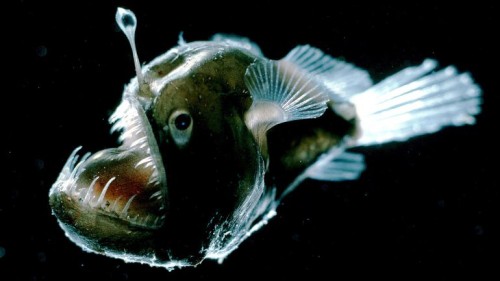Location: Caffe Nero Marina Limassol
Year: 2015
Meditation science festival
Koupa
Coldest, oldest, fastest : 10 extreme sea creatures
Coldest, oldest, fastest : 10 extreme sea creatures – these are amazing, both in looks and facts. Here are my favorite two.

Photo: Edith Widder
Anglerfish inhabit the deep sea, and for a century they baffled marine biologists. At first only female anglerfish were known; where the males were and what they looked like was a complete mystery. Then a parasitologist began studying the worm-like parasites generally attached to anglerfish females. What he found, instead of parasites, were anglerfish males — each undergoing a radical transformation. When a male anglerfish is tiny, he finds and attaches to a female. First his jaws dissolve and his bloodstream fuses with the female’s. Then his brain disappears and his guts shrink. Eventually he is little more than a testis, fertilizing the eggs of one female, for the rest of his life.

CC BY-SA 3.0
Photo: Nick Hobgood
Purple anemone (Heteractis magnifica) and resident anemonefish (Amphiprion ocellaris) (clownfish) in East Timor.
http://en.wikipedia.org/wiki/Ocellaris_clownfish#mediaviewer/File:Anemone_purple_anemonefish.jpg
Clownfish families were made famous in ‘Finding Nemo,’ but real ones have more peculiar lives than the movie lets on. In a sea anemone where the clownfish live, the biggest fish is always a female, laying all the eggs. The next biggest fish is a functional male, fertilizing them. And lots of smaller clownfish are immature males. When the female dies or is eaten by a predator, the biggest male switches sex to become female. At the same time the biggest immature male grows into a functional male that can fertilize the eggs. This conveyor belt system of parenting assures a constant supply of baby Nemos.
House of Keys
Here’s yet another research confirming how much of a myth online security really is – “House of Keys: Industry-Wide HTTPS Certificate and SSH Key Reuse Endangers Millions of Devices Worldwide“:
We have correlated our data with data from Internet-wide scans (Scans.io and Censys.io) and found that our data set (580 unique keys) contains:
- the private keys for more than 9% of all HTTPS hosts on the web (~150 server certificates, used by 3.2 million hosts)
- the private keys for more than 6% of all SSH hosts on the web (~80 SSH host keys used by 0.9 million hosts)
So in total at least 230 out of 580 keys are actively used. Other research has pointed out the extent of this problem (Heninger, Nadia, et al. “Mining Your Ps and Qs: Detection of Widespread Weak Keys in Network Devices“, Durumeric, Zakir, et al. “Analysis of the HTTPS certificate ecosystem“). However using our approach, an attribution at a vendor/product level is now possible. Plus the private keys have now been obtained.


